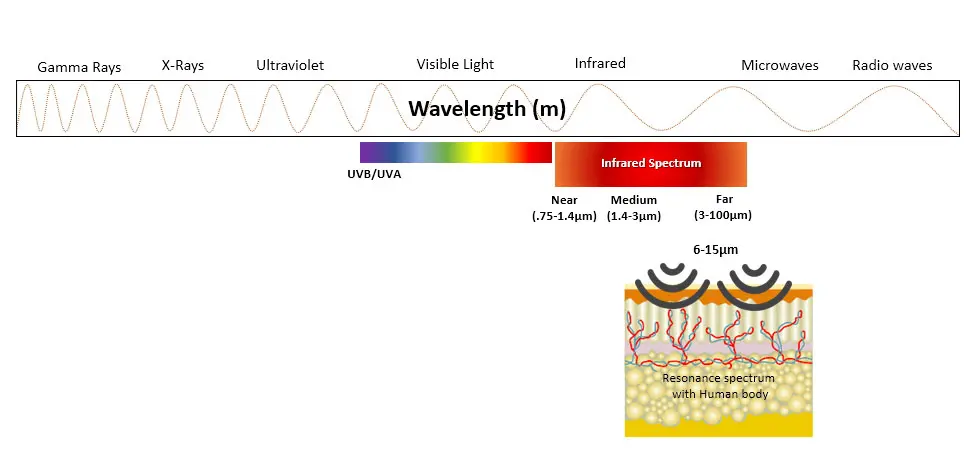
Far-Infrared (FIR) Therapy
The Far-Infrared FIR is a subset of the infrared electromagnetic spectrum that just falls outside of visible light and has the longest wavelength within the infrared spectrum. It has a waveband width of 3μm – 100μm. Despite being part of the solar spectrum, it cannot be seen with the naked eye. However, this spectrum performs an important role in delivering radiant heat, and indeed, plays a critical role in promoting life and wellbeing on Earth. The far-infrared range of waves, 6μm – 15μm, is known to have therapeutic effects on the human body – and is also known as the resonance spectrum, as explained in the following sections.
Biological Effects of Far-Infrared (FIR)
There is more than just the sun that radiates FIR, the human body as well emits FIR. The majority of FIR spectrum released by our body is in the range of 6-15μm, with a peak around 9μm. That is why the specific FIR spectrum between 6 and15μm has shown therapeutic effects on humans – it is the resonance effect that is responsible for this.

Like Pulsed Magnetic Field (PEMF) therapy, electromagnetic waves at the FIR range interact with cells, membranes, body fluids – namely water, DNA/protections, and so on to cause stimulation. One of these factors is water, which makes up approximately 60% of a person’s body and plays a significant role in the transport of nutrients and toxic substances. FIR energy can penetrate skin up to six centimeters depending on the wavelength, power, and location of application.
The key benefits of Far Infrared Ray (FIR) includes
- Improves micro-circulation by increasing the vibrational levels of bonds in molecules, especially water molecules in our body
- Increases oxygen supply to tissues, particularly damaged tissues, in order to promote healing
- Serve as a non-invasive, safe form of physiotherapy for the relief of pain and the recovery of injuries
- Increasing evidence suggests that FIR can also improve the health of patients with cardiovascular disease, diabetes mellitus, and chronic kidney disease.
- When applied on a larger surface area, FIR can increase the body’s core temperature, which can trigger the innate immune response (i.e. cells that produce antibodies).
Choosing the Right Far-Infrared Devices
There are a variety of infrared devices available on the market, but not all are designed as pure Far-Infrared devices. The majority of devices employ a combination of red light and infrared (which means a wider spectrum of light). A pure far-infrared device has the following two characteristics:
- No Light emitted. FIR emitted non-visible light (EMR)
- Radiated heat. (This will differentiate from Near-Infrared NIR devices, which also do not emit light, but neither heat).
What to look out for in FIR Devices
There are many types of FIR devices available. It can take the form of a hand paddle, a small pad around your body, a foot warmer, a full-body mat to lie on, an FIR sauna, a standing FIR lamp, etc. Besides the quality of the product, its design, and its form, you should also investigate the source of the heating and the level of dirty electromagnetic fields it is emitting. Radiation from far infrared sources is present in all heat. All heated devices, however, are not infrared devices. Ideally, FIR devices should not have a surface that is too hot (unacceptable) to touch, since heat is radiated rather than transferred to the surface. It is similar to an induction cooker, in which heat energy is transmitted through electromagnetic fields.
The FIR generating material in most quality FIR devices is ceramic, natural marble, or carbon fibre. The surface is usually warm to the touch, and when applied to the body, you can feel a warming sensation deep within, not just on the surface. In the picture below, a high-quality far-infrared mattress from Europe is shown, in which the heat signature is only detected on the carbon fibre that emits the FIR.

Relevant Clinical Studies on FIR and Body Temperature:
- Far infrared radiation (FIR): its biological effects and medical applications – Fatma Vatansever and Michael R. Hamblin*
- Far-infrared therapy for cardiovascular, autoimmune, and other chronic health problems: A systematic review
- Infrared therapy for chronic low back pain: A randomized, controlled trial
- Body Temperature during Hibernation Is Highly Correlated with a Decrease in Circulating Innate Immune Cells
